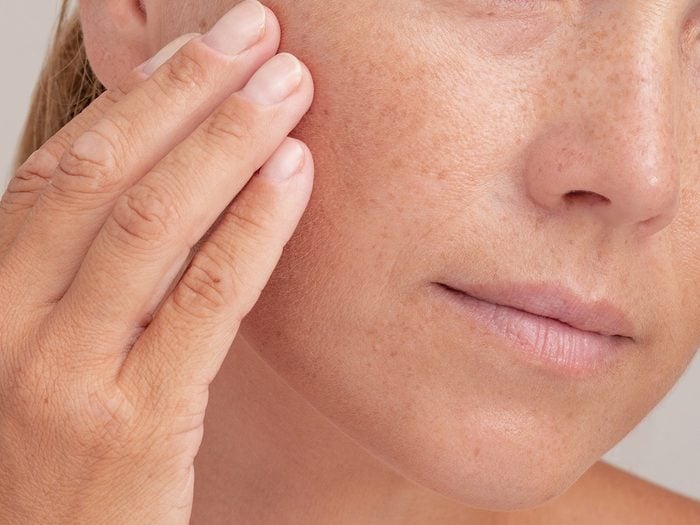How to Treat Dark Spots, According to an Expert

Whether you call them sun spots, age spots, or—our least-fave term—liver spots, they’re all signs of sun damage to your skin.
‘Tis the season for afternoon patio drinks, reading on the dock and weekends spent gardening—all of which increase your time outdoors and contribute to the sun damage your skin absorbs over the years. Often, this sun exposure will turn into dark spots or age spots: hyper-pigmented, light-brown blemishes that are bigger than freckles.
We asked Neha Goyal, a cosmetic MD in Toronto, how to identify, prevent and treat them.
What’s the difference between sun spots, age spots, hyperpigmentation and—our least fave term for them—liver spots? Are these terms synonymous?
Sun spots, liver spots and age spots are all names used to describe hyper-pigmented flat, brown or black spots that appear on the skin, particularly on areas that have been exposed to the sun, such as the face, hands and shoulders. Sometimes patients can get “white sun spots,” which refers to hypo-pigmented spots that occur from UV damage as well.
Hyperpigmentation is simply a visible darkening of one area, compared to the surrounding skin, which can be caused by a number of things.
Is this the same thing as melasma?
No, melasma is a common chronic skin condition that results in the development of brown or greyish-brown patches on the face, typically on the forehead, cheeks and upper lip. It occurs due to the overproduction of melanin, which is the pigment that gives colour to our skin. Melasma is more common in women experiencing hormonal changes, particularly those who are pregnant, experiencing menopause or taking birth control pills or hormone replacement therapy—but it can affect anyone. Sun exposure, hormonal changes and genetics are all believed to play a role. Not all treatments available for hyperpigmentation can be used to treat melasma, which is why it’s important to meet with a knowledgeable clinician to come up with the right treatment plan.
Do sun spots equal sun damage? Can they turn into skin cancer? What should you keep an eye on if you’re noticing them as you age?
Yes, sun spots do reflect a form of sun damage, and are caused by UV radiation from the sun or other sources (like tanning beds). While sun spots are considered harmless in and of themselves, they are a sign of sun damage, which can increase a person’s risk of skin cancer. Fair-skinned individuals are more likely to develop both sun spots and skin cancer. The ABCDEs of skin cancer are an easy way to try to assess suspicious lesions. If you’re someone who has many spots, or a personal or family history of skin cancer, the best option for monitoring would be to get an annual skin check through your dermatologist.
What can I do if I already have age spots? Besides, obviously, continuing to wear sunscreen and a hat?
There are many affordable topical agents that have been shown to be effective for reducing hyperpigmentation: retinoids, kojic acid, azelaic acid, vitamin C, niacinamide and tranexamic acid. These ingredients work by various mechanisms, such as inhibiting the production of melanin, promoting skin cell turnover and reducing inflammation in the skin. Prescription creams that contain hydroquinone can also be prescribed and used under the guidance of a physician.
For me, the two most important skincare products to use are a retinoid and sunscreen with an SPF 50+, and to use these consistently. Once these skincare ingredients are on board and are being tolerated, I would gradually introduce other skin lightening agents, depending on the nature of the hyperpigmentation.
Does vitamin C serum help fade or lighten your age spots?
Yes! Vitamin C can help hyperpigmentation by inhibiting melanin production, which is responsible for dark spots and hyperpigmentation. But it’s important to remember that not all vitamin C products are created equal, and a product’s efficacy is linked to its concentration and stability. We prefer 100-percent ascorbic acid mixed immediately prior to use. This helps retain 100-percent efficacy of the vitamin, which is unstable by nature and sensitive to both light and temperature. Make sure you’re mixing it into a product with a low pH.
Can facial peels or dermaplaning help reduce age spots?
Absolutely. In-clinic services like chemical peels can help to exfoliate the outer layer of skin, which will further help lighten the spots. The peel solution itself is the workhorse here, but the dermaplaning allows the solution to penetrate more effectively in the skin. Peel treatments every four to eight weeks will definitely help lighten most hyperpigmentation.
There are also light-based treatments like lasers (for example PicoWay) or intense pulsed light (IPL) treatments, which can help target the pigment in the sun spots and break them down, helping the body to eliminate them. The pigmented skin will grow darker for a week and then eventually slough off on its own.
Is something like IPL safe for darker or more melanated skin?
In tanned, medium or dark skin tones, you need to be careful with IPL, is as it could potentially cause more hyper- or hypo-pigmentation. For these patients I recommend the PicoWay device or something called Morpheus8.
This interview has been edited and condensed for clarity.




